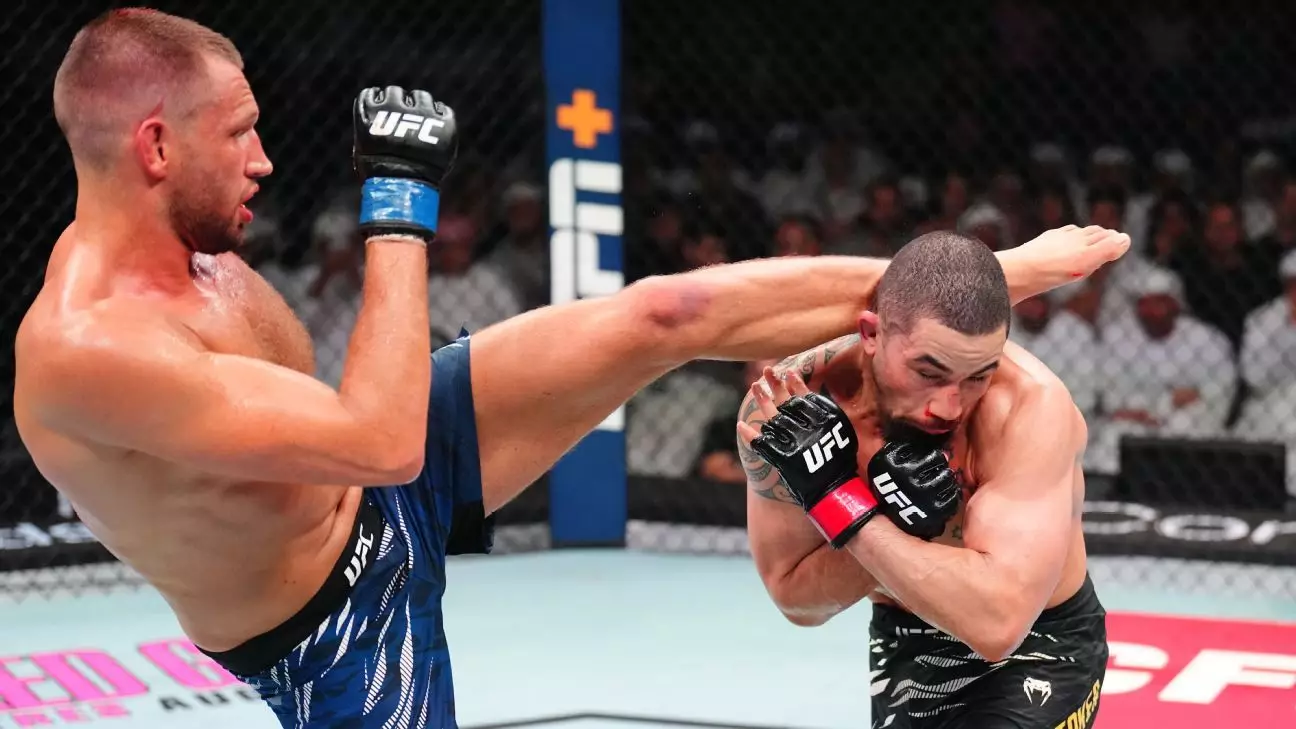In the competitive landscape of UFC’s middleweight division, Reinier de Ridder’s latest triumph against Robert Whittaker marks more than a mere victory; it signifies a compelling shift in the division’s hierarchy. Many fighters are content with measuring success through highlight reels and quick finishes, but de Ridder’s performance was a calculated display of dominance, endurance, and strategic resilience. His split decision win, despite being razor-thin on the judges’ scorecards, underscores a pivotal point: volume and pressure often outweigh raw knockout power. This fight demonstrated that de Ridder’s blend of grappling prowess and relentless aggression is enough to challenge even the most durable and revered competitors in the sport.
What gives de Ridder’s triumph its particular edge is not just the win itself but the manner in which he achieved it. Landing over 169 strikes and controlling the fight for nearly ten minutes reveals a fighter willing to impose his will relentlessly. His approach disrupts the conventional narrative that striking alone dictates cage success; instead, it champions the idea that sustained pressure, volume, and tactical takedown attempts can carve out victories from even the most seasoned opponents.
His willingness to lean into his grappling background was evident, but it was his strategic pressure and stamina that carried the day, rather than relying solely on submissions or knockouts. This approach emphasizes a maturing of his fighting philosophy—balancing aggression with cage control to outlast opponents. It’s a blueprint that could redefine what it means to be a top contender at 185 pounds.
Challenging a Legend and Redefining Risks
Facing Robert Whittaker—a fighter whose resilience and striking versatility are the stuff of middleweight legend—de Ridder proved he’s capable of competing at the highest echelon. Whittaker’s famous durability was on full display, as he weathered de Ridder’s constant assaults and even responded with a spectacular counter right hand in the third round, nearly finishing the Dutchman on the spot. Such moments highlight Whittaker’s experience and tactical acumen, yet they also expose a critical vulnerability: the toll of relentless pressure.
De Ridder’s strategy not only challenged Whittaker physically but also psychologically. His willingness to engage, exchange strikes, and commit to takedowns demonstrates a fighter unafraid of risk—a trait that is essential for those seeking to climb the ranks. But this comes with a caveat: the risk of overcommitment or burnout. De Ridder’s sustained pace and volume indicate a fighter who is still learning how to perfectly balance aggression with stamina to maintain effectiveness throughout five rounds. His recognition of this is evident when he admits a desire to finish fights earlier in future bouts.
This victory also raises important questions about de Ridder’s future matchups. He’s not content with being a mere gatekeeper but is actively positioning himself as a title challenger. His call-out of the division’s elite, including Khamzat Chimaev and Dricus du Plessis, is a strategic move rooted in confidence but also underpins a broader philosophy: to be the hunted, one must first challenge the hunter. His recent performances have demonstrated that he is willing to face any test—not just the easiest, but the most challenging—to prove his worth.
Implications for the Middleweight Division and Beyond
De Ridder’s rise cannot be viewed in isolation; it signifies a potent shift in the division. Traditionally dominated by striking specialists and well-rounded fighters, middleweight now faces a fresh, relentless contender who marries grappling with aggressive striking volume. His victory over Whittaker, a top-five ranked fighter, signals that the division’s landscape is evolving beyond the established names.
Furthermore, de Ridder’s victory at the age of 34 illustrates that UFC fighters can still defy age-related expectations if they adapt strategically and train intelligently. His recent streak of wins—three in a single year—demonstrates that persistence, combined with tactical acumen, can accelerate a fighter’s ascent regardless of the years ticking by. His performance not only challenges the existing hierarchy but also injects a new style—high-pressure grappling combined with striking—that could become the hallmark of future champions.
While some critics might argue that de Ridder’s style is too attritional or that his victories lack the spectacular finish many fans crave, his methodical approach reveals a different kind of mastery—one based on dominance, endurance, and strategic adaptability. In a division craving fresh blood and new stories, Reinier de Ridder appears poised to become a story worth following. The question now is not whether he’ll get a shot at the title, but whether he’s ready to dethrone the reigning champions through sheer resilience and relentless execution.


Leave a Reply